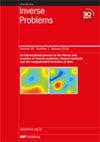在没有地面实况的情况下比较维纳-亨特解卷积模型的最佳贝叶斯策略
IF 2
2区 数学
Q1 MATHEMATICS, APPLIED
引用次数: 0
摘要
本文研究了在没有地面实况数据的情况下进行解卷积的几种替代模型的定量比较。考虑到超大数据集的应用,我们重点研究基于维纳滤波器的线性去卷积模型。虽然这种模型相对简单,但在高分辨率图像复原等大规模应用中却非常普遍,因为它们能很好地权衡精度和计算量。然而,为了提供精确的解决方案,需要对模型进行适当的校准,以捕捉相关未知量和测量误差的协方差结构。这种校准通常需要繁重的控制实验和广泛的专家监督,以及定期的重新校准程序。本文采用无监督贝叶斯统计方法进行模型评估,只需使用观测数据,无需地面实况数据或受控实验,即可对备选模型进行比较。因此,可以根据数据对模型的后验概率进行定量比较,后验概率来自模型的边际似然或证据。这些证据的计算非常不容易,本文考虑了三种不同的策略来解决这一难题--Chib 方法、拉普拉斯近似和截断谐波期望--所有这些都可以通过使用专门针对这类模型的吉布斯采样算法来有效实现。除了实现无监督模型选择外,吉布斯采样器的输出还可用于自动估计未知模型参数,如测量误差方差和未知感兴趣量的功率。我们在一系列图像解卷积问题上演示了所提出的策略,这些策略用于比较仪器点扩散函数和未知图像协方差矩阵以及测量误差的不同建模选择。本文章由计算机程序翻译,如有差异,请以英文原文为准。
An optimal Bayesian strategy for comparing Wiener–Hunt deconvolution models in the absence of ground truth
This paper considers the quantitative comparison of several alternative models to perform deconvolution in situations where there is no ground truth data available. With applications to very large data sets in mind, we focus on linear deconvolution models based on a Wiener filter. Although comparatively simple, such models are widely prevalent in large scale setting such as high-resolution image restoration because they provide an excellent trade-off between accuracy and computational effort. However, in order to deliver accurate solutions, the models need to be properly calibrated in order to capture the covariance structure of the unknown quantity of interest and of the measurement error. This calibration often requires onerous controlled experiments and extensive expert supervision, as well as regular recalibration procedures. This paper adopts an unsupervised Bayesian statistical approach to model assessment that allows comparing alternative models by using only the observed data, without the need for ground truth data or controlled experiments. Accordingly, the models are quantitatively compared based on their posterior probabilities given the data, which are derived from the marginal likelihoods or evidences of the models. The computation of these evidences is highly non-trivial and this paper consider three different strategies to address this difficulty—a Chib approach, Laplace approximations, and a truncated harmonic expectation—all of which efficiently implemented by using a Gibbs sampling algorithm specialised for this class of models. In addition to enabling unsupervised model selection, the output of the Gibbs sampler can also be used to automatically estimate unknown model parameters such as the variance of the measurement error and the power of the unknown quantity of interest. The proposed strategies are demonstrated on a range of image deconvolution problems, where they are used to compare different modelling choices for the instrument’s point spread function and covariance matrices for the unknown image and for the measurement error.
求助全文
通过发布文献求助,成功后即可免费获取论文全文。
去求助
来源期刊

Inverse Problems
数学-物理:数学物理
CiteScore
4.40
自引率
14.30%
发文量
115
审稿时长
2.3 months
期刊介绍:
An interdisciplinary journal combining mathematical and experimental papers on inverse problems with theoretical, numerical and practical approaches to their solution.
As well as applied mathematicians, physical scientists and engineers, the readership includes those working in geophysics, radar, optics, biology, acoustics, communication theory, signal processing and imaging, among others.
The emphasis is on publishing original contributions to methods of solving mathematical, physical and applied problems. To be publishable in this journal, papers must meet the highest standards of scientific quality, contain significant and original new science and should present substantial advancement in the field. Due to the broad scope of the journal, we require that authors provide sufficient introductory material to appeal to the wide readership and that articles which are not explicitly applied include a discussion of possible applications.
 求助内容:
求助内容: 应助结果提醒方式:
应助结果提醒方式:


